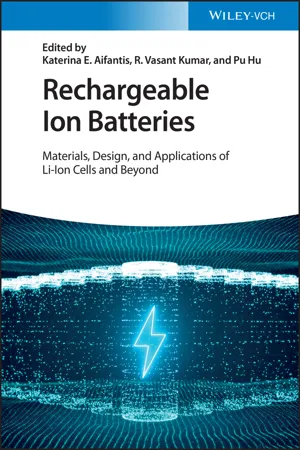Chemistry
Galvanic and Electrolytic Cells
Galvanic and electrolytic cells are two types of electrochemical cells. In a galvanic cell, spontaneous chemical reactions produce electrical energy, while in an electrolytic cell, electrical energy is used to drive non-spontaneous chemical reactions. Galvanic cells are commonly used in batteries to provide power, while electrolytic cells are used in processes like electroplating and electrolysis.
Written by Perlego with AI-assistance
Related key terms
Related key terms
1 of 4
Related key terms
1 of 3
11 Key excerpts on "Galvanic and Electrolytic Cells"
- eBook - ePub
Electrical Engineering
Fundamentals
- Viktor Hacker, Christof Sumereder(Authors)
- 2020(Publication Date)
- De Gruyter Oldenbourg(Publisher)
6 Electrochemistry6.1 Basic electrochemical concepts
With special regard to electrical engineering, this chapter covers the branch of electrochemistry that deals with the generation and storage of electric current. The electrochemical oxidation and reduction reactions take place at the phase boundaries of the electrode and the electrolyte.Galvanic cellChemical energy is transformed into electrical energy, current is produced, and electrochemical reactions take place spontaneously (negative free enthalpy). Galvanic cells are categorised into three subgroups:- Primary cells
- Secondary cells
- Fuel cells
Electrolytic cellElectric energy is transformed into chemical energy. Two electrodes made of electron-conducting material, and the electrolytes with ion conductivity are conductively connected62 to each other. At the two spatially separated electrodes electrochemical reactions take place.Half-cellA half-cell consists of one single electrode and an electrolyte into which the electrode is submerged (e.g. copper in a copper sulphate solution). If a (metal) electrode is submerged into a metal salt solution (same metal), the surface of the electrode becomes charged. With base metals (e.g. zinc) some metal atoms enter the solution and the released electrons stay on the surface of the electrode, which is now negatively charged. The positively charged metal ions remain bound to the negatively charged metal surface. Thereby an electrical double layer is formed where the negative and the positive charges balance each other out. When two half-cells are combined, a galvanic cell (connected through ionic conductor and electron conductor) is formed.Anode - Mark Kernion, Joseph A. Mascetta(Authors)
- 2021(Publication Date)
- Barrons Educational Services(Publisher)
voltaic cells, utilize spontaneous redox reactions in which the transfer of electrons is made to occur through a wire. Electrical devices attached to a galvanic cell can be made to operate, taking advantage of the electrical energy produced. A package of one or more galvanic cells is known as a battery.In order to make the transfer of electrons take place through a wire, the substance being reduced must be separated from the one being oxidized. One way for this to occur is to place a porous barrier between the materials in a container that houses both. The barrier prevents the particles involved in the reduction process from mixing with the particles from which it will procure electrons. In contact, these substances liberate energy in the form of heat. Separated, the natural push to transfer the electrons from one substance to another is made through the conduit of the electrically conducting metal wire. The porous nature of the barrier allows for the charge that builds up in each compartment (due to the electron transfer through the wire) to dissipate as charged particles migrate through it. A specific example of the galvanic cell described above is shown on page 263 .Simple Galvanic CellThe Zn strip is in an aqueous solution of ZnSO4 . The Cu strip is in an aqueous solution of CuSO4 . Both solutions conduct electricity as both ZnSO4 and CuSO4 are strong electrolytes. The zinc and copper strips are both electrodes. Electrodes are conductors used to establish electrical contact with a nonmetallic part of a circuit, such as an electrolytic solution. Each of the electrodes immersed in their respective solutions constitutes half of the cell where either oxidation or reduction will occur. In this case, the zinc electrode immersed in the zinc sulfate solution is where oxidation takes place and is called the anode. The copper strip immersed in the copper (II) sulfate solution is where reduction takes place and is called the cathode- eBook - ePub
- A.P.H. Peters(Author)
- 2010(Publication Date)
- CRC Press(Publisher)
There are three principal types of electrochemical cells. In an electrolytic cell, a current is passed by an external driving force, causing an otherwise nonspontaneous chemical reaction to proceed. In a galvanic cell, the progress of a spontaneous chemical reaction causes the electric current to flow, doing work on the surroundings. An equilibrium electrochemical cell is at the state between an electrolytic cell and a galvanic cell. The tendency of a spontaneous reaction to push a current through the external circuit must be balanced by an external source of e.m.f. that exactly cancels this tendency. If this counter e.m.f. is increased beyond the equilibrium value the cell becomes an electrolytic cell, and if it is decreased below the equilibrium value the cell becomes a galvanic cell.We could measure the cell e.m.f. (E) by matching it with an exactly equal, but opposite, e.m.f. from a potentiometer. The cell e.m.f. will be a measure of the free energy for the cell reaction if the electrodes are truly reversible and if potentials at the liquid junction are negligible. Reversibility implies that an external e.m.f. infinitesimally greater than E causes the cell reaction to be reversed (compare “external pressure” for gaseous work). This is not true of all cells.To maintain electrical neutrality in each cell compartment, negative ions move from right to left, within the cell, and positive ions move in the opposite direction. In general, they will have different transport numbers; that is, they move at different rates and so carry different proportions of the total current. This results in a small liquid junction potential, which disturbs the cell e.m.f. reading. (Space allows only a brief account of transport numbers to be included here. For a more complete account, the works of Moore [1 ] and Potter [2 ] are recommended.) If, instead of using a porous plate, as in the simple Daniell cell, a salt bridge is used to link the two electrolytes, the junction potential is minimized. A salt bridge is generally a tube of agar jelly containing a solution of either KCl or NH4 NO3 - eBook - ePub
- P. L. Silveston, R. R. Hudgins(Authors)
- 2012(Publication Date)
- Butterworth-Heinemann(Publisher)
(9-2) fall into the second category.When the above reactions occur simultaneously in a cell, the resulting overall reaction is the electrolysis of water, i.e.,(9-3)Since this process is not spontaneous, the cell must be connected to an electric power source in order for the reactions of EqsConsider now a cell in which the above reactions proceed in the opposite direction, i.e.,(9-1) and (9-2)to proceed as written above. A cell in which electric current drives half-cell reactions that would otherwise not occur is termed an electrolytic cell.(9-4)(9-5)Obviously, the reaction of Eq. (9-4) involves oxidation and occurs at the anode, while the reaction of Eq. (9-5) involves reduction and occurs at the cathode. These half-cell reactions will combine to produce the following overall reaction:(9-6)Since this overall reaction proceeds spontaneously, connecting the anode and cathode to an external load enables electric current to flow through the load. These reactions form the basis for fuel cells that generate electrical energy. Such a cell is termed a galvanic cell. While fuel cells and batteries serve useful purposes, other galvanic processes, such as corrosion, are harmful and obviously undesirable. Galvanic processes are those that produce electrical energy.It is not possible to independently control cell potential and current during the operation of an electrochemical cell. Consequently, a cell can be operated only in one of two possible modes—galvanostatic or potentiostatic. During galvanostatic operation, current is applied in the case of an electrolytic cell or generated in a galvanic cell according to some controlled manner and the resulting potential can be monitored. This mode is commonly used in industry, primarily because it enables direct control of the production rate. During potentiostatic operation, a potential is applied (or generated) in some controlled manner and the resulting current can be monitored. This mode is typically preferred in situations where galvanostatic operation leads to an inefficient process or poor deposit quality (in the case of plating). Such a situation often arises when more than one reaction occurs at an electrode surface and selectivity of the desired reaction is improved by careful control of potential. - eBook - ePub
Rechargeable Ion Batteries
Materials, Design, and Applications of Li-Ion Cells and Beyond
- Katerina E. Aifantis, R. V. Kumar, Pu Hu(Authors)
- 2022(Publication Date)
- Wiley-VCH(Publisher)
1 Introduction to Electrochemical Cells R. Vasant Kumar 1 and Thapanee Sarakonsri 2 1 University of Cambridge, Department of Materials Science and Metallurgy, 27 Charles Babbage Road, Cambridge, CB3 0FS, UK 2 Chiang Mai University, Department of Chemistry, Faculty of Science, Chiang Mai, 50200, Thailand 1.1 What are Batteries? The purpose of this chapter is to provide basic knowledge on batteries, which will allow for their general understanding. Therefore, after defining their components and structure, an overview of the quantities that characterize these storage devices will be given. Scientifically, batteries are referred to as electrochemical or galvanic cells, due to the fact that they store electrical energy in the form of chemical energy and because the electrochemical reactions that take place are also termed galvanic. Galvanic reactions are thermodynamically favorable (the free‐energy difference, Δ G, is negative) and occur spontaneously when two materials of different positive standard reduction potentials are connected by an electronic load (meaning that a voltage is derived). The material with the lower positive standard reduction potential undergoes oxidation providing electrons by the external circuit to the material with the higher positive standard reduction potential, which in turn undergoes a reduction reaction. These half‐reactions occur concurrently and allow for the conversion of chemical energy to electrical energy by means of electron transfer through an external circuit. It follows that the material with the lower positive standard reduction potential is called the negative electrode or anode on discharge (since it provides electrons), while the material with the higher positive standard reduction is called the positive electrode or cathode on discharge (since it accepts electrons) - eBook - ePub
Electrochemical Energy Storage
Physics and Chemistry of Batteries
- Reinhart Job(Author)
- 2020(Publication Date)
- De Gruyter(Publisher)
eq. (3.139 ), we also can use the following expression:(3.140)E=c e l l0E−r e d0Eo x0In this expression E0 red is related to the electrode, where the reduction occurs (i.e., at the cathode); and E0 ox is related to the electrode, where the oxidation occurs (i.e., at the anode). In a galvanic cell, the less noble metal operates as an anode, where oxidation occurs [half-reaction, where metal ions from the anode dissolve into the electrolyte leaving electrons behind in the anode (loss of electrons)]. The nobler electrode is the cathode, where reduction occurs (gain of electrons). Hence, electricity is generated due to the electric potential difference between the two different metal electrodes of each half-cell, and the potential difference results from the difference between the individual potentials of the two metal electrodes with respect to the electrolyte.If the Gibbs free energy is positive (ΔG0 cell > 0), we speak about an electrolytic cell that undergoes a redox reaction, when electrical energy is applied. Such a cell is used for the decomposition of chemical compounds, for instance, the decomposition of water into hydrogen and oxygen. The electrolytic cell also consists of two half-cells. In a galvanic cell, chemical energy is converted into electrical energy, and in an electrolytic cell, electrical energy is converted into chemical energy.The overall potential of a galvanic cell (or an electrochemical cell including electrolytic cells) can be measured. Usually this is done against the SHE. However, there is no simple way to measure the potential between an electrode and the electrolyte, that is, the isolated potential of the half-cell. In this sense, the standard electrode potential is the electromotive force that can be measured in a galvanic cell that consists of one half-cell with the electrode under consideration and the other half-cell with the SHE.The SHE was already mentioned in Section 3.2.2. As explained earlier, the standard electrode potentials are measured relative to the SHE, and for that matter, the SHE potential is defined as 0 V. For the sake of comparability, such measurements have to be carried out under standard conditions. The standard electrode potentials of metals and semimetals are arranged in the galvanic series. - eBook - ePub
Electrochemical Science and Technology
Fundamentals and Applications
- Keith Oldham, Jan Myland, Alan Bond(Authors)
- 2011(Publication Date)
- Wiley(Publisher)
4 ions. The current crosses each of the electronic|ionic junctions by virtue of electrochemical reactions.Figure 3-2 In its galvanic mode the lead-acid cell provides energy to a “load”. The cell voltage is less than its equilibrium value.The chemistry at the electrode surfaces is no longer in equilibrium. Interconversions in both directions are still taking place, but they are no longer occurring at equal rates. A convenient way of representing a departure from equilibrium is by using arrows of unequal length in the equation. At the left-hand electrode, the process becomes3:15with the forward process now outrunning the backward conversion. Therefore a net reduction occurs. An electrode at which a reduction is occurring is termed a cathode. Conversely, at the right-hand electrode, the backward process outruns the forward:3:16and a net oxidation occurs. An electrode at which an oxidation is occurring is described as an anode. Electrons are consumed at a cathode, created at an anode. As Figure 3-2 illustrates, the cell voltage falls somewhat below its equilibrium value during this process – the greater the current, the larger the drop – as a result of electrode polarization. This is a phenomenon with several causes, as described in detail in Chapter 10.As the two electrochemical reactions proceed, the Gibbs energy of the cell’s contents steadily declines as chemical energy is converted into work or heat. The conversion of chemical energy, through electrical energy, to work can approach 100% efficiency; there is no Carnot limitation314 ,541 .An electrochemical cell, such as that we have been describing, in which chemical energy is being destroyed is named a galvanic cell 315 . Conversely, when a cell captures electrical energy and converts it to chemical energy, it is said to be acting as an electrolytic cell. Figure 3-3 - eBook - ePub
- Jeffrey Gaffney, Nancy Marley(Authors)
- 2017(Publication Date)
- Elsevier(Publisher)
The zinc-air battery produces 1.35–1.4 V in most available cells and is used in a number of common applications including “button” batteries used in watches and hearing aids. Larger battery styles constructed to optimize the amounts of zinc and air input are used as cylindrical cells for safety lamps at road and rail construction sites or as power sources for electric fences. When sealed, the battery has an excellent shelf life with a self discharge rate of only two percent per year. Zinc-air batteries also store more energy per gram than any other primary battery. However, they are sensitive to extreme temperatures, humidity, and carbon dioxide concentrations. High levels of carbon dioxide can cause the formation of carbonates which reduces electrical conductivity.Important Terms
Anode the electrode in a galvanic cell where the oxidation reaction occurs.Battery an electrical device consisting of one or more galvanic cells, with external connections provided to allow the battery to power electrical devices.Cathode the electrode in a galvanic cell where the reduction reaction occurs.Cathodic protection a method of protecting structural metal components by using a more easily oxidized metal as an anode, making the protected metal as the cathode of a galvanic cell.Cell potential the electrical potential energy difference between two half cells of a galvanic cell.Concentration cell a form of galvanic cell where both half cells have the same composition with differing concentrations.Dry cell a battery that uses an electrolyte in the form of a paste or a solid.Electrochemistry the study of chemical processes that cause electrons to move.Electrode a solid conductor through which an electrical current enters or leaves a galvanic cell.Electrolysis a process which uses an external electrical current to drive a nonspontaneous oxidation-reduction reactionElectrolyte a substance that can conduct electricity due to its ability to dissociate into ions when dissolved.Electromotive force (emf) a measure of the ability of a half cell to drive the electric current from the interior to the exterior of the cell. - eBook - ePub
Understanding Molecules
Lectures on Chemistry for Physicists and Engineers
- Franco Battaglia, Thomas F. George(Authors)
- 2018(Publication Date)
- CRC Press(Publisher)
It is a Galvanic cell (or Galvanic element), composed of two semi-elements (or semicells), namely two electrodes, each immersed into a distinct electrolytic solution. The two semicells are connected to each other by means of a porous membrane, or by any other device allowing a flow of electric current. This flows when the circuit is closed externally, i.e., when the two electrodes are connected by a conducting wire (typically, of course, a resistive component is inserted, such as the bulb in Figure 14.1, if the electric current has some purpose to accomplish). We note that in these conditions, the electric potential difference between the electrodes, Δ V, depends on the applied resistance, R, according to Ohm’s law: Δ V = IR, where I is the electric current intensity. The electric potential difference referred to above, Δ E = V cathode − V anode, is that measured between the two electrodes when no current flows, and it is called the electromotive force (emf) of the cell (the name is somewhat misleading: the emf of a Galvanic cell is not a force but a voltage). The copper-zinc Galvanic cell where the reaction (14.1) occurs is known as a Daniell cell. The experimental arrangement shown in Figure 14.1 is usually denoted as a sequence of the electric circuit elements as in Zn|Zn 2+ ||Cu 2+ |Cu, where each vertical bar represents the interface between the phases (the double bar represents the porous membrane between the two semi-elements). The usual convention requires us to write to the right the electrode toward which, in the external circuit, the electrons flow when the cell is working. In order to uniquely specify the system, extra information is inserted, such as the solution composition - eBook - ePub
- C. Vincent, Bruno Scrosati(Authors)
- 1997(Publication Date)
- Butterworth-Heinemann(Publisher)
y − 1)+(aq). As charge transfer (in the appropriate direction) at the interfaces produces exactly the same result as the homogeneous electron exchange, the whole cell process, including the electron flow through the load resistor, will also be spontaneous, driven by the net free energy change associated with the cell reaction. This is the essence of the electrochemical or galvanic cell, which is thus seen to be a device which allows the direct conversion of chemical into electrical energy.Fig. 2.1 Basic electrochemical cell. Interconnection of the two electrodes through the external load resistor allows the spontaneous cell reaction to proceedThe quantity of a chemical species reduced or oxidized in an electrochemical cell is related by Faraday’s Laws to the total electric charge transferred acoss the metal–solution interfaces. A current of i amps flowing in the circuit for a time of δt seconds is equivalent to the transfer of i. δt coulombs of charge across any interface in the cell. Now if the oxidation of each Mx +(aq) ion involves the transfer of one electron from the solution phase to the electrode (Fig. 2.1 ), then the passage of i .δt coulombs must correspond to the oxidation ofi δ t /Le omoles of Mx +(aq), where e o is the charge on an electron (1.601 × 10− 19 C), and L is the Avogadro constant, or number of atoms in a mole (6.022 × 1023 ). The term (Le o ) is given the name Faraday’s constant, F , and has a value of 96 490 C mol− 1 . For the more general electrode processMx +a q− n e →Mx + n+a qeach Mx +(aq) ion gives up n electrons to the external circuit in order to form the oxidized product. Here the number of moles of reactant Mx +(aq) consumed by the passage of a current, i , flowing for a period δt is given byN M=i δ tnF(2.2)Since the current passing through a cell is often a function of time, a more general form of equation (2.2) isN M=1 nF∫ 0 ti d t(2.2′)where the integration is carried out over the interval during which current passes. Conversely, if N M represents the total number of moles of Mx - Serguei N. Lvov(Author)
- 2021(Publication Date)
- CRC Press(Publisher)
GC in which fuel is used as one of the cell chemicals.- The cathode (and the anode) can be either positive or negative. In a GC , the cathode is positive, and in an EC , the anode is positive. If an electrochemical cell can work in both modes (galvanic and electrolytic), each of the electrodes can be either the cathode or the anode. However, the electrode polarity remains the same. In a rechargeable battery, the electrodes should be called positive electrode and negative electrode.
- Electrochemical diagrams show the materials (chemicals) and phases of electrochemical cell. The traditional diagrams have some challenges, so a new type of diagrams is suggested in this book.
- Faraday’s law connects the chemical and electric processes taking place in an electrochemical system.
- In this book, the 2006 self-consistent set of values of the fundamental constants recommended by the CODATA are used. While it may sound unusual, it is suggested to remember four fundamental constants (R, N
A, e, and F) to be used in solving a variety of problems offered in the book.- The reader should recognize the difference between resistance and resistivity (conductance and conductivity). It is important to know the relationship between the conductor resistance (conductance), resistivity (conductivity), and the conductor geometry.
- Ohm’s, Kirchhoff’s, and Joule’s laws are used to connect the cell potential, current, resistances, and power of an electrochemical cell. The Daniell cell is used as an example to demonstrate these relationships.
- The cell potential–current dependences for equilibrium cell, GC , and EC s are considered, and recommendations on making the self-consistent and thermodynamically correct diagrams are provided.
2.17 Exercises
PROBLEM 1Construct the traditional and new electrochemical diagrams for the electrolytic cell shown in Figure 2.3
Index pages curate the most relevant extracts from our library of academic textbooks. They’ve been created using an in-house natural language model (NLM), each adding context and meaning to key research topics.
Explore more topic indexes
Explore more topic indexes
1 of 6
Explore more topic indexes
1 of 4










